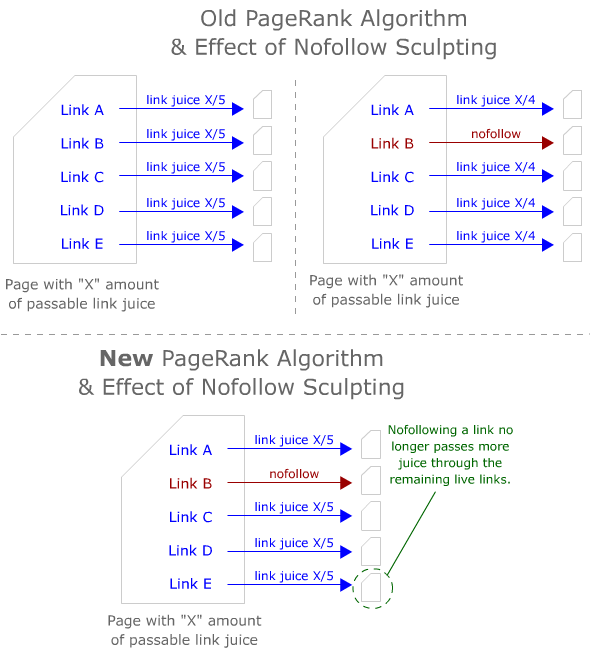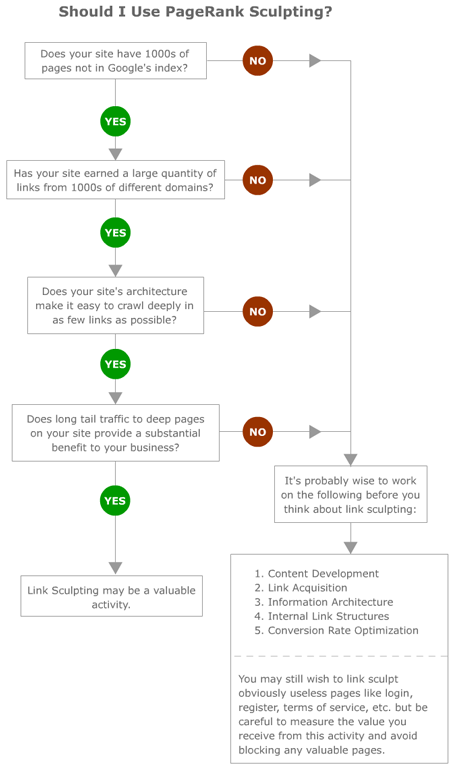
Google (Maybe) Changes How the PageRank Algorithm Handles Nofollow
The author's views are entirely their own (excluding the unlikely event of hypnosis) and may not always reflect the views of Moz.
Today's article from Search Engine Land: Google Loses "Backwards Compatibility" on Paid Link Blocking & PageRank Sculpting is a must read, but it's frustratingly hard to understand Google's position shift on the topics. In this post I'll talk briefly about the "change" and how it may affect webmasters and SEO best practices, as well as examining some of the bizarreness that surrounds this issue.
First off, an excerpt from SELand:
So today at SMX Advanced, sculpting was being discussed, and then Matt Cutts dropped a bomb shell that it no longer works to help flow more PageRank to the unblocked pages. Again — and being really simplistic here — if you have $10 in authority to spend on those ten links, and you block 5 of them, the other 5 aren’t going to get $2 each. They’re still getting $1. It’s just that the other $5 you thought you were saving is now going to waste.
Further, it was explained that YouTube wasn’t doing sculpting way back in 2007 as a way to boost certain video content. Instead, it was that YouTube randomly shows some video content and didn’t want these random selections to perhaps gain more authority than they should. And even with the change announced today, that still works. In the past, the unblocked videos got more authority money and the blocked ones got none. Now, the unblocked videos still get authority money — just not as much — and the blocked ones still get none.
Let's do a quick visual explanation of what's supposedly happened:

I have to say, I'm a little skeptical that this is an accurate and fully honest description of what Google's changed. It's certainly possible, and historically, their representatives at conferences haven't been known to issue directly dishonest statements, but at the same time, this is a massive shift in how PageRank is calculated and seems unlikely to me to have a positive impact on search quality.
I suspect the change is because many people have been abusing nofollow internally to attempt to game Google as well as abusing it in the sense that they've actually hurt their site's relevance and quality in the results (this latter seems more likely to me). I've mentioned in the past that you need to be very careful with PageRank sculpting as a practice, but let me illustrate again with a quick flowchart.

Basically, PR sculpting is useful on large domains, with thousands of pages and issues getting those deep pages enough link juice (PageRank) to stay in Google's main web index and appear for long tail search queries. Historically, in our consulting business, we've experienced terrific results sculpting the flow of PR to deep pages and growing the indexation rates of those sites. If Google has made this shift, we should expect those positive results to reverse themselves, but to date there's been no outcry of lost rankings and traffic to deep pages from the sites we've worked with. Of course, finding correlation in the web environment is nearly impossible due to the lack of a static landscape, but still....
The funny thing about all this to my mind is that if Google really has changed to treat nofollows as link "sinks" that consume PageRank but don't flow it, they're really only screwing over the sites that are only semi-familiar or semi-serious about SEO. Savvy SEOs are just going to go back to the old method of PageRank sculpting that existed long before nofollow - creating links that robots can't see or follow (in Flash, in external Javascript calls that are blocked, in plug-in content, etc.) to get around the issue. It's sad, too, because it rewards those paranoid SEOs who didn't listen/believe Google's acceptance of PR sculpting with nofollow and kept doing it the old fashioned way, and casts doubts on whether we can trust future messaging around SEO best practices, too.
I've got to say this is one of the more bizarrely counter-intuitive moves I've seen from Google, but I still think we don't have the whole story. Let's see what the follow-up questions and answers bring before we make any drastic decisions.
p.s. Via Linkscape, we can see that ~2.7% of the 474,779,069,489 (474 Billion) links in our index are nofollowed, and of these, 73% are internal links. We're talking about a massive change to the web's link graph, affecting more than 9.3 Billion links - for more stats on this front, see my old post, Lessons Learned Building an Index of the WWW.




Comments
Please keep your comments TAGFEE by following the community etiquette
Comments are closed. Got a burning question? Head to our Q&A section to start a new conversation.